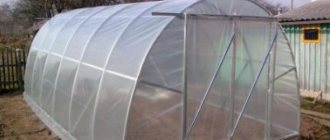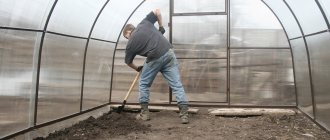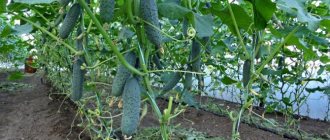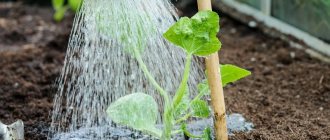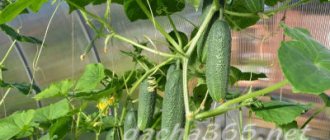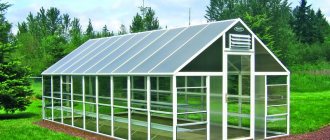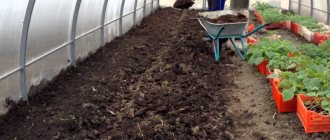Many people dream of a permanent swimming pool at their dacha, even grandparents who want to please their grandchildren who come to them on vacation. But most summer residents have to abandon this idea for various reasons: due to the need to constantly monitor the cleanliness of the water, remove the structure during their absence, etc. If you install a pool in a polycarbonate greenhouse, most of these problems will be automatically solved.
Water in an outdoor pool gets clogged very quickly Source solargil.com.br
Pros and cons of frame
The advantages of such pools include:
possibility of all-season recreation;- no danger of sun exposure;
- clean water without foreign debris and leaves;
- an additional element of improving the landscape design of the site;
- natural heating of water in summer without auxiliary electrical appliances;
- accessibility of installation and ease of design;
- no evaporation of water from the pool.
Having a large number of advantages, swimming pools in greenhouses also have a number of disadvantages , which will definitely need to be taken into account when building and creating a project:
- mandatory installation of a water filtration system;
- proper and timely ventilation of the room;
- the need for large financial expenditures on the purchase of related materials and consumables;
- the need for maximum proximity to a water source and possible drains.
If you compare all the pros and cons, then the positive aspects can still convince the owner of the site of the need to build a pool in a greenhouse.
What should a pool cover look like?
When planning to install an indoor pool on a site, it is important to think through the design of the “dome” down to the smallest detail: where to place it, what to make it from, what shape and size to choose.
Materials for production
If you want to have a comfortable and low-maintenance pool, the greenhouse above it should be made of moisture-resistant materials, allow light and heat to pass through well, be easy to clean and be durable - resistant to wind, snow and mechanical loads.
Therefore, it is advisable not to make the frame from wood, which will quickly rot from high humidity, or ordinary steel, which is easily susceptible to corrosion.
Wood can be used subject to high-quality antiseptic impregnation and regular renewal of the protective coating Source odstroy.ru
See also: Catalog of companies that specialize in engineering systems (heating, water supply, sewerage and others) and related work
These problems will not arise if you install a frame made of galvanized or protected with high-quality powder coating steel pipes. Stainless steel and aluminum alloys are also resistant to corrosion, but are more expensive. A lightweight portable frame can be made using polypropylene water pipes.
It is best to choose cellular polycarbonate as a coating. The film is short-lived and retains heat less well in cool weather, and glass is too fragile a material for a structure such as a swimming pool. Especially if children will be frolicking in it.
A greenhouse pool with a polycarbonate cover has many advantages. This material:
- lightweight yet durable;
- flexible, easy to install and create complex shapes;
- transparent enough for sunlight, but scattering it, making it softer;
- polycarbonate with a special UV coating protects against harmful radiation;
- not afraid of moisture and temperature changes;
- easy to care for;
- It can be not only transparent, but also colored.
A colored dome looks more interesting Source kraskomposit.rf
Shapes and sizes
The greenhouse for the pool must be resistant to strong winds and withstand snow loads. Therefore, it can be given a standard shape - arched or gable. Such structures have been tested for years, but they look too simple and unpresentable. If there are no special complaints about the appearance of the swimming complex, it is quite possible to use ready-made greenhouses, choosing the appropriate size.
You can emphasize the special purpose of the greenhouse and set it apart from a number of garden structures with non-standard forms - domed, asymmetrical or combined. For example, with a straight facade wall and a semi-arched roof. You can attach a lean-to structure to the wall of the house.
This design is difficult to confuse with a regular greenhouse Source masterspa39.ru
Necessary calculations before construction
Before starting construction, it is necessary to draw up a plan and preliminary estimate:
Determining the location on the site where the pool will be located.- Determining the condition of the old greenhouse frame (if any). If there is no frame, you will need to purchase one.
- Choosing a bowl shape.
- It will be necessary to stock up on tools and materials - concrete, shovel, concrete mixer, sand, wooden beam, screwdriver or drill, polycarbonate, fastening materials, wheelbarrow or stretcher, wrenches, bubble level, skewers, spatulas, jigsaw, as well as ventilation and heating systems and water filtration.
Approximate cost of materials:
| Tools and materials | Price/Cost per 1 unit of product (RUB) |
| Shovel with handle | 400 |
| Concrete mixer | 15000 |
| Sand (25 kg) | 70 |
| Wooden beam | 1800 |
| Screwdriver | 3000 |
| Greenhouse | 12000 |
| Greenhouse installation by a specialist | 5000 |
| Pool bowl | 12000 |
| Cement (25 kg) | 185 |
| Filtration unit | 40000 |
| Air heater | 10000 |
| Fasteners, hardware, accessories | 4000 |
| Stairs and handrails | 20000 |
| TOTAL: | 123455 |
These are the basic outlines of the pre-construction plan and estimate. It will be difficult to calculate the exact amount of costs, since you first need to decide on the shape of the frame and bowl. The final amount will depend on them.
Polycarbonate is the main favorite
If you only need protection from wind, debris and “ubiquitous” insects, then a simple structure is used to build a pavilion; it consists of a wooden frame and plastic film. This option will be cheaper, the shelter will perform its functions, but the temperature inside the greenhouse above the pool will not be comfortable during the cold season.
The second potential method is to use glass. In this case, the pool will become more comfortable, but the material has significant drawbacks, due to which glass for greenhouses is increasingly being abandoned. This is heaviness along with fragility, high thermal conductivity. The last minus becomes the main Achilles heel in winter.
With the advent of new covering material, all the others hid in the shadows. Polycarbonate has become a hit and deservedly so; its characteristics are to blame for this:
- strength, reliability, both important qualities are also combined with light weight;
- enviable flexibility, allowing you to obtain designs of unusual shapes;
- excellent light transmittance, high ability to diffuse light;
- durability and ease of maintenance;
- resistance to moisture, fire;
- huge assortment.
Photos of options
General information
A modern pool in a polycarbonate greenhouse can be equipped with your own hands. It is enough to see numerous photos of such structures. Translucent materials have been used for several years as pavilions over artificial reservoirs. The polycarbonate coating gives such structures a very finished and aesthetic appearance.
The main purposes of such structures are:
- protecting water bodies from pollution and reducing the need for regular cleaning;
- the ability to use the pool in almost any weather conditions;
- significant extension of the life of the pool bowl and reduction of repair or maintenance costs;
- reducing costs for electricity or other heating options;
- effective protection of swimmers from harmful ultraviolet radiation on sunny days;
- the possibility of arranging a comfortable recreation area in close proximity to the pool.
Depending on the height parameters, the structure can be low, with a height of no more than fifty centimeters, and high, which covers only the bowl of the reservoir or allows you to arrange an internal area in addition to the pool
You can choose the most interesting and convenient option for each specific site after viewing the introductory photos. Even beginners and people who do not have special construction skills can build most structures with their own hands.
Operation and Maintenance
In order for a pool in a polycarbonate greenhouse to last a long time, it is necessary to carefully care for it:
- Greenhouse frame. Do not forget to periodically inspect and treat metal racks with anti-corrosion compounds.
- Polycarbonate coating. Washing and cleaning sheets at least 2 times a year.
- Inspection and maintenance of the water filtration system.
- Using means to clean the bowl from the effects of fungus and mold.
A swimming pool in a polycarbonate greenhouse can last a long time only if it is provided with significant and attentive care.
The most important and useful information about frame pools is presented here.
Video description
This video provides an overview of a low sliding pavilion made of monolithic polycarbonate:
- Stationary greenhouses are made tall, in which you can walk around the pool at full height.
On a note! Greenhouses with straight vertical walls are much more convenient and spacious; arched structures have to be made larger in area due to the loss of height on the sides.
It is better to select the dimensions of the structure in accordance with the parameters and method of installing the pool bowl. For tanks sunk into the ground, the height of the shelter can be made smaller. It is advisable to leave at least 30-40 cm of free space around the entire perimeter between the sides of the pool and the walls of the greenhouse, otherwise you will only have to dive into it through the door.
This option is also acceptable, but less convenient Source stroy-rossiya.rf
Plant compatibility
When choosing what to plant in a greenhouse and what on the street, you need to understand the agricultural technology of plants and their compatibility. This is a separate and very serious agronomic topic with an emphasis on selection, and simply the accumulated experience of summer residents running their own farm with its constant expansion. But even a novice summer resident should know some nuances so as not to ruin his first plantings and not be disappointed in the new greenhouse!
- Planting a cucumber is compatible with growing peppers, eggplants, radishes, dill, legumes, and spinach in a greenhouse;
- Tomatoes can be planted with legumes, radishes, garlic, herbs: basil, celery and parsley!
Mixed plantings:
- Radishes, tomatoes, onions, and various types of salads show completely normal joint growth;
- Peppers and eggplants!
It is not recommended to combine the following plantings:
- Tomatoes and cucumbers;
- Sorrel, spinach and cabbage;
- Eggplants and tomatoes!
A greenhouse and its care, growing a variety of crops inside a prepared structure and in open ground is a real science that has been studied for years, often even through trial and error, because individual conditions are created at each dacha. Therefore, a careful approach to agricultural technology, calculations are required... but, most importantly, the desire for a positive result, thanks to which everything will work out!
Greenhouse-pyramid
The pyramid is another original, but not very common type of greenhouse in our country. Meanwhile, it’s worth taking a closer look at it. Many summer residents have noticed that vegetables and fruits grow faster in a tetrahedral pyramid than in ordinary “houses.” But you should not endow such a structure with magical properties. There is a scientific explanation for everything. It’s just that both sunlight and air flows are optimally distributed in a transparent pyramid.
You can assemble a pyramid greenhouse in the same way as a dome, from triangular modules - a rigid frame and translucent filling.
The procedure for performing construction work
To equip a greenhouse pool, you will need “water” plastic pipes and fittings, pipes for laying the cable and the cable itself, waterproof lamps, circulation sediment and a skimmer (a device for filtering water)
Building a greenhouse yourself “from scratch” is a thankless and economically unprofitable task. Profiled pipes, screws, silicone washers and polycarbonate sheets purchased separately (and, as a rule, with a reserve) are much more expensive in total than a ready-made factory design. Carrying out all the calculations and making a drawing of the building is not easy. In addition, without experience, it is not always possible to correctly mark and cut out the details of a structure; it can be especially difficult to make its doors and windows. Therefore, a homemade greenhouse, assembled with great difficulty, often looks mowed and does not look aesthetically pleasing.
In order not to have to worry about marking the mounting holes and adjusting the plastic panels, it is better to buy a set of elements for making a greenhouse (or order it at the factory), and just mount them yourself and install the greenhouse on a pre-filled strip foundation.
You can install a ready-made frame pool in the greenhouse
Installing the bowl
- In the selected area, trenches are dug for laying communications and a foundation pit for installing a plastic bowl.
- A thick sand cushion is placed at the bottom of the excavated pit, moistened and thoroughly compacted.
- The walls of the pit are completely lined with 25 mm boards impregnated with antiseptic.
- The polymer bowl is lowered into the prepared pit. The gaps between its walls and the wooden frame are filled with dry seeded sand and compacted thoroughly.
- Pipes are laid in the trenches, connected to the bowl and the joints are checked for tightness.
- The ditches are filled up and the bowl is temporarily covered with plank shields.
If the pool will be used in winter, heating must be provided
Mini-greenhouses
Those who are not ready to build houses for plants will certainly appreciate ready-made mini-greenhouses, which you can simply buy and install on your site. Their range is truly huge - from small boxes with cells used for germinating seedlings, to full-fledged greenhouses, albeit of a modest size, which can be equipped with irrigation, heating and lighting systems. Mini-greenhouses are distinguished by extreme ease of use and thoughtful design. Manufacturers compete with each other, creating more and more original and beautiful designs that can become a real decoration of the site. Or the interior, if it is a small greenhouse in which seeds are ripening.
Plastic, glass or film?
When starting to build a greenhouse, we inevitably face a choice: film, glass or polycarbonate? The cheapest option for filling frames is, of course, film. But whether such savings are justified is a moot point. Even with the most careful handling, the film will only last one or two seasons, and then the structure will have to be covered again.
Glass, on the other hand, can last for many decades. It perfectly transmits sunlight, and if you put double-glazed windows in the greenhouse, it will also serve as a reliable heat insulator, protecting plants even in cold weather. Only such a greenhouse, as they say, “will cost a pretty penny.”
Polycarbonate can be called the golden mean. In terms of light transmission, it is not much inferior to glass. At the same time, it is 20 times lighter and much, much cheaper. The material bends well, has high strength and retains heat well. As a rule, sheets with a thickness of 4 mm are used for temporary greenhouses, and 6 or 8 mm for permanent greenhouses.
